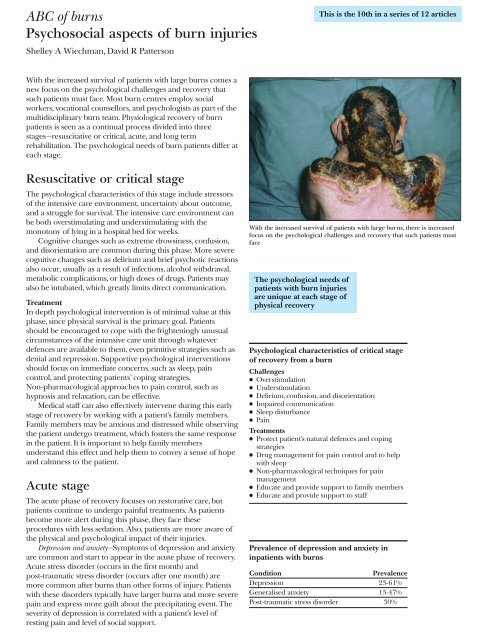ABC of Burns
You also want an ePaper? Increase the reach of your titles
YUMPU automatically turns print PDFs into web optimized ePapers that Google loves.
<strong>ABC</strong> <strong>of</strong> burns<br />
Psychosocial aspects <strong>of</strong> burn injuries<br />
This is the 10th in a series <strong>of</strong> 12 articles<br />
Shelley A Wiechman, David R Patterson<br />
With the increased survival <strong>of</strong> patients with large burns comes a<br />
new focus on the psychological challenges and recovery that<br />
such patients must face. Most burn centres employ social<br />
workers, vocational counsellors, and psychologists as part <strong>of</strong> the<br />
multidisciplinary burn team. Physiological recovery <strong>of</strong> burn<br />
patients is seen as a continual process divided into three<br />
stages—resuscitative or critical, acute, and long term<br />
rehabilitation. The psychological needs <strong>of</strong> burn patients differ at<br />
each stage.<br />
Resuscitative or critical stage<br />
The psychological characteristics <strong>of</strong> this stage include stressors<br />
<strong>of</strong> the intensive care environment, uncertainty about outcome,<br />
and a struggle for survival. The intensive care environment can<br />
be both overstimulating and understimulating with the<br />
monotony <strong>of</strong> lying in a hospital bed for weeks.<br />
Cognitive changes such as extreme drowsiness, confusion,<br />
and disorientation are common during this phase. More severe<br />
cognitive changes such as delirium and brief psychotic reactions<br />
also occur, usually as a result <strong>of</strong> infections, alcohol withdrawal,<br />
metabolic complications, or high doses <strong>of</strong> drugs. Patients may<br />
also be intubated, which greatly limits direct communication.<br />
Treatment<br />
In depth psychological intervention is <strong>of</strong> minimal value at this<br />
phase, since physical survival is the primary goal. Patients<br />
should be encouraged to cope with the frighteningly unusual<br />
circumstances <strong>of</strong> the intensive care unit through whatever<br />
defences are available to them, even primitive strategies such as<br />
denial and repression. Supportive psychological interventions<br />
should focus on immediate concerns, such as sleep, pain<br />
control, and protecting patients’ coping strategies.<br />
Non{pharmacological approaches to pain control, such as<br />
hypnosis and relaxation, can be effective.<br />
Medical staff can also effectively intervene during this early<br />
stage <strong>of</strong> recovery by working with a patient’s family members.<br />
Family members may be anxious and distressed while observing<br />
the patient undergo treatment, which fosters the same response<br />
in the patient. It is important to help family members<br />
understand this effect and help them to convey a sense <strong>of</strong> hope<br />
and calmness to the patient.<br />
Acute stage<br />
The acute phase <strong>of</strong> recovery focuses on restorative care, but<br />
patients continue to undergo painful treatments. As patients<br />
become more alert during this phase, they face these<br />
procedures with less sedation. Also, patients are more aware <strong>of</strong><br />
the physical and psychological impact <strong>of</strong> their injuries.<br />
Depression and anxiety—Symptoms <strong>of</strong> depression and anxiety<br />
are common and start to appear in the acute phase <strong>of</strong> recovery.<br />
Acute stress disorder (occurs in the first month) and<br />
post{traumatic stress disorder (occurs after one month) are<br />
more common after burns than other forms <strong>of</strong> injury. Patients<br />
with these disorders typically have larger burns and more severe<br />
pain and express more guilt about the precipitating event. The<br />
severity <strong>of</strong> depression is correlated with a patient’s level <strong>of</strong><br />
resting pain and level <strong>of</strong> social support.<br />
With the increased survival <strong>of</strong> patients with large burns, there is increased<br />
focus on the psychological challenges and recovery that such patients must<br />
face<br />
The psychological needs <strong>of</strong><br />
patients with burn injuries<br />
are unique at each stage <strong>of</strong><br />
physical recovery<br />
Psychological characteristics <strong>of</strong> critical stage<br />
<strong>of</strong> recovery from a burn<br />
Challenges<br />
x Overstimulation<br />
x Understimulation<br />
x Delirium, confusion, and disorientation<br />
x Impaired communication<br />
x Sleep disturbance<br />
x Pain<br />
Treatments<br />
x Protect patient’s natural defences and coping<br />
strategies<br />
x Drug management for pain control and to help<br />
with sleep<br />
x Non-pharmacological techniques for pain<br />
management<br />
x Educate and provide support to family members<br />
x Educate and provide support to staff<br />
Prevalence <strong>of</strong> depression and anxiety in<br />
inpatients with burns<br />
Condition<br />
Prevalence<br />
Depression 23-61%<br />
Generalised anxiety 13-47%<br />
Post-traumatic stress disorder 30%



